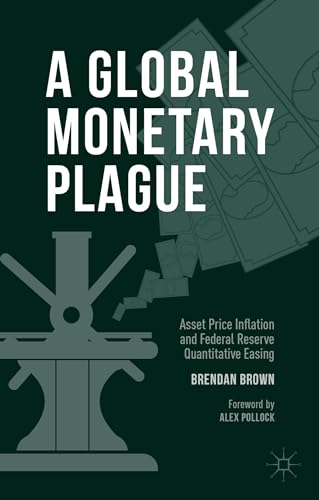A Global Monetary Plague: Asset Price Inflation and Federal Reserve Quantitative Easing - Hardcover

Zu dieser ISBN ist aktuell kein Angebot verfügbar.
Alle Exemplare der Ausgabe mit dieser ISBN anzeigen:Die Inhaltsangabe kann sich auf eine andere Ausgabe dieses Titels beziehen.
Dr. Brown gives the first clear and coherent explanation of the dire effects on the economy of the Federal Reserve's Great Monetary Experiment. He artfully and completely debunks two great myths of our age: that periods of secular price deflation are destabilizing; and that the Japanese 'lost decade' was caused by deflation. Most important, Brown brilliantly integrates elements of behavioral finance with sound monetary theory to explain how the Fed's policy of manipulating interest rates is sowing the seeds of a future financial crisis of global scope by systematically distorting the market mechanism that brings the market interest rate into accord with the neutral rate. If you want to truly understand where the economy is headed and why, this is the only book worth reading.
(Joseph T. Salerno, Professor of Economics, Pace University, New York, NY, and, Academic Vice President, Mises Institute, Auburn, AL)
„Über diesen Titel“ kann sich auf eine andere Ausgabe dieses Titels beziehen.
- VerlagPalgrave Macmillan
- Erscheinungsdatum2015
- ISBN 10 1137478845
- ISBN 13 9781137478849
- EinbandTapa dura
- Anzahl der Seiten252
Neu kaufen
Mehr zu diesem Angebot erfahren
Versand:
EUR 5,24
Von Vereinigtes Königreich nach USA
Beste Suchergebnisse beim ZVAB
A Global Monetary Plague : Asset Price Inflation and Federal Reserve Quantitative Easing
Buchbeschreibung hardback. Zustand: New. Language: ENG. Artikel-Nr. 9781137478849
Weitere Informationen zu diesem Verkäufer | Verkäufer kontaktieren
A Global Monetary Plague : Asset Price Inflation and Federal Reserve Quantitative Easing
Buchbeschreibung Buch. Zustand: Neu. Druck auf Anfrage Neuware - Printed after ordering - The Great Monetary Experiment designed and administered by the Federal Reserve under the Obama Administration unleashed strong irrational forces in global asset markets. The result was a 'monetary plague' which has attacked and corrupted the vital signalling function of financial market prices.This book analyses how quantitative easing caused a sequence of markets to become infected by asset price inflation. It explains how instead of bringing about a quick return to prosperity from the Great Recession, the monetary experiment failed in its basic purpose. Bringing about economic debilitation, major financial speculation, waves of mal-investment in particular areas, and a colossal boom in the private equity industry, the experiment instead produced monetary disorder.Brendan Brown puts the monetary experiment into a global and historical context, examining in particular Japanese 'folklore of deflation' and the Federal Reserve's first experiment of quantitative easing in the mid-1930s. The author couples analysis from the Austrian school of monetary economics and Chicago monetarism with insights from behavioral finance, and concludes with major proposals for the present and the future, including ideas for monetary reform in the United States, and suggestions for how investors can survive the current market 'plague'. Artikel-Nr. 9781137478849
Weitere Informationen zu diesem Verkäufer | Verkäufer kontaktieren

